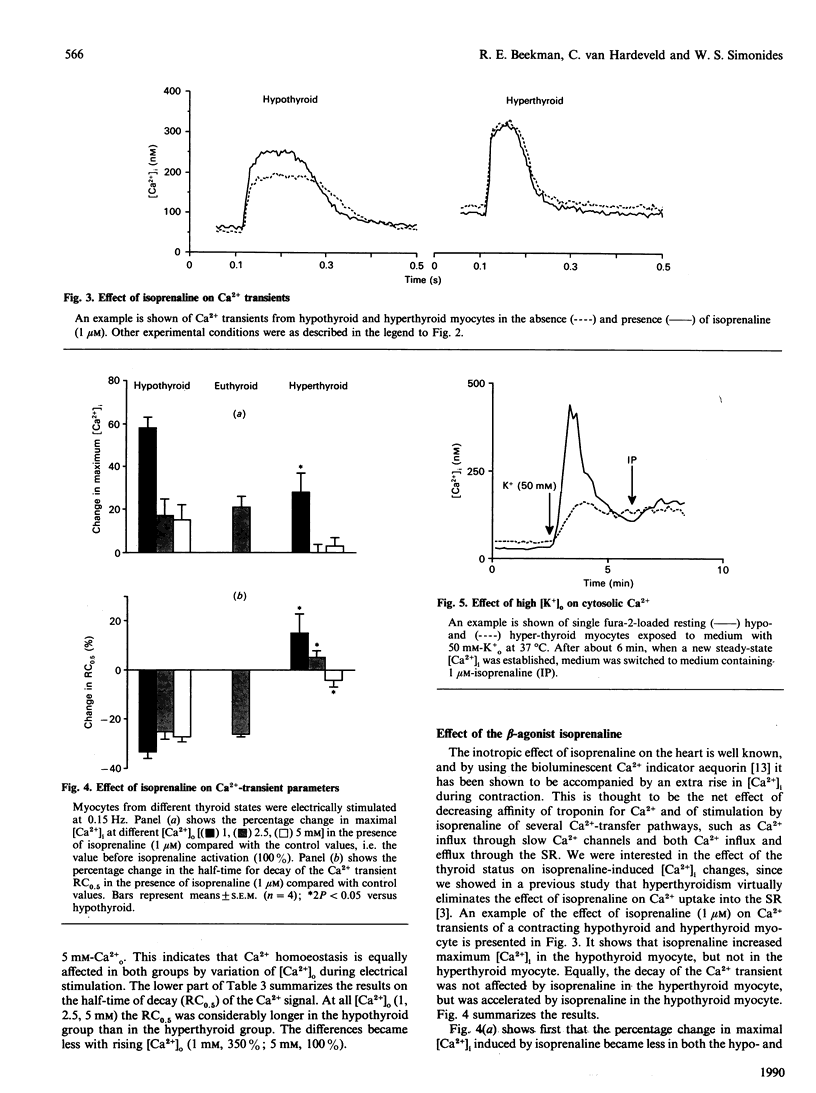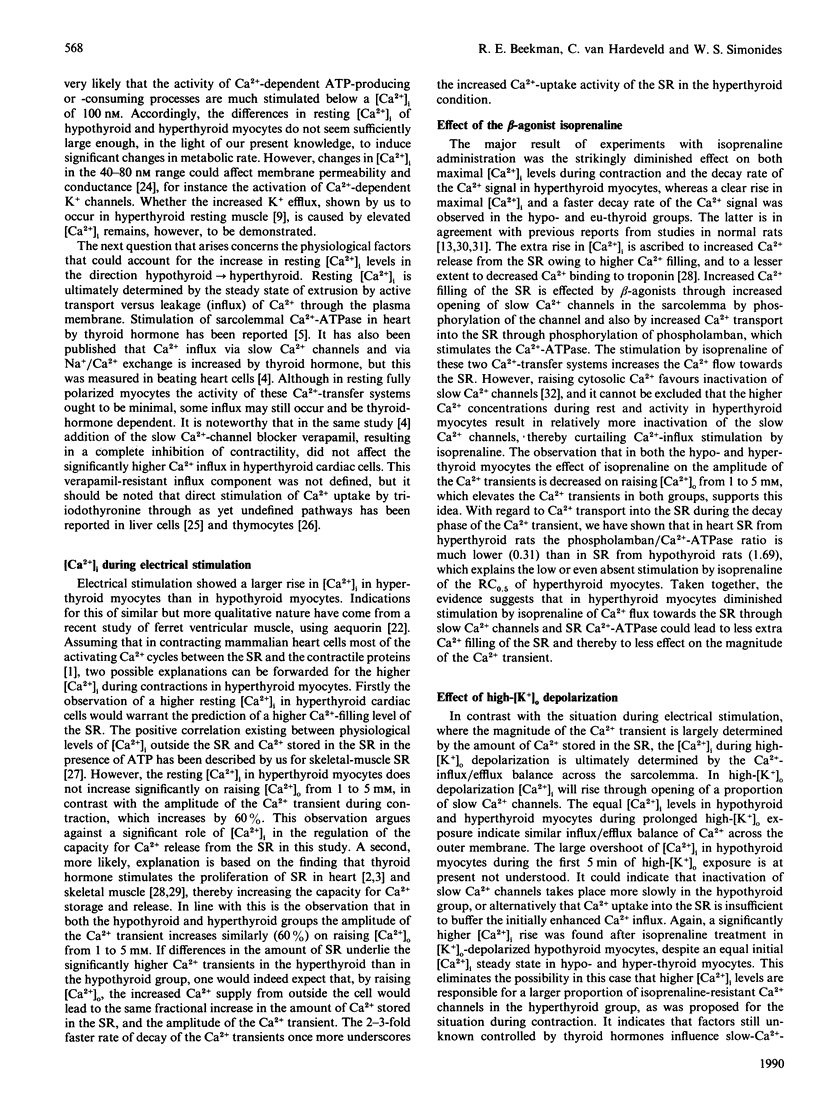Abstract
The effects of the thyroid status on the cytosolic free Ca2+ concentration ([Ca2+]i) in single cardiomyocytes were studied at rest and during contraction. The mean resting [Ca2+]i increased significantly from the hypothyroid (45 +/- 4 nM) through the euthyroid (69 +/- 12 nM) to the hyperthyroid condition (80 +/- 11 nM) at extracellular Ca2+ concentrations ([Ca2+]o) up to 2.5 mM. At [Ca2+]o above 2.5 mM the differences in [Ca2+]i between the groups became less. The amplitude of the Ca2+ transients became higher in all groups with increasing [Ca2+]o (1, 2.5 and 5 mM), and was highest at all [Ca2+]o in hyperthyroid myocytes. The beta-agonist isoprenaline elevated peak [Ca2+]i during contraction and increased the rate of the decay of the Ca2+ transients to a greater extent in hypothyroid myocytes than in hyperthyroid myocytes. Depolarization with high [K+]o induced a large but transient [Ca2+]i overshoot in hypothyroid myocytes, but not in hyperthyroid myocytes, before a new elevated steady-state [Ca2+]i was reached, which was not different between the groups. When isoprenaline was added to K+ o-depolarized myocytes after a steady state was reached, a significantly larger extra increase in [Ca2+]i was measured in the hypothyroid group (28%) compared with the hyperthyroid group (8%). It is concluded that in cardiac tissue exposed to increasing amounts of thyroid hormones (1) [Ca2+]i increases at rest and during contraction in cardiomyocytes and (2) interventions which favour Ca2+ entry into the cytosol [( Ca2+]o elevation, high [K+]o, beta-agonists) tend to have less impact on Ca2+ homoeostasis.
Full text
PDF






Selected References
These references are in PubMed. This may not be the complete list of references from this article.
- Allen D. G., Blinks J. R. Calcium transients in aequorin-injected frog cardiac muscle. Nature. 1978 Jun 15;273(5663):509–513. doi: 10.1038/273509a0. [DOI] [PubMed] [Google Scholar]
- Beekman R. E., van Hardeveld C., Simonides W. S. Effect of thyroid state on cytosolic free calcium in resting and electrically stimulated cardiac myocytes. Biochim Biophys Acta. 1988 Apr 2;969(1):18–27. doi: 10.1016/0167-4889(88)90083-3. [DOI] [PubMed] [Google Scholar]
- Beekman R. E., van Hardeveld C., Simonides W. S. On the mechanism of the reduction by thyroid hormone of beta-adrenergic relaxation rate stimulation in rat heart. Biochem J. 1989 Apr 1;259(1):229–236. doi: 10.1042/bj2590229. [DOI] [PMC free article] [PubMed] [Google Scholar]
- Cannell M. B., Berlin J. R., Lederer W. J. Effect of membrane potential changes on the calcium transient in single rat cardiac muscle cells. Science. 1987 Dec 4;238(4832):1419–1423. doi: 10.1126/science.2446391. [DOI] [PubMed] [Google Scholar]
- Chapman R. A. Control of cardiac contractility at the cellular level. Am J Physiol. 1983 Oct;245(4):H535–H552. doi: 10.1152/ajpheart.1983.245.4.H535. [DOI] [PubMed] [Google Scholar]
- Endoh M., Blinks J. R. Actions of sympathomimetic amines on the Ca2+ transients and contractions of rabbit myocardium: reciprocal changes in myofibrillar responsiveness to Ca2+ mediated through alpha- and beta-adrenoceptors. Circ Res. 1988 Feb;62(2):247–265. doi: 10.1161/01.res.62.2.247. [DOI] [PubMed] [Google Scholar]
- Grynkiewicz G., Poenie M., Tsien R. Y. A new generation of Ca2+ indicators with greatly improved fluorescence properties. J Biol Chem. 1985 Mar 25;260(6):3440–3450. [PubMed] [Google Scholar]
- Hansford R. G., Lakatta E. G. Ryanodine releases calcium from sarcoplasmic reticulum in calcium-tolerant rat cardiac myocytes. J Physiol. 1987 Sep;390:453–467. doi: 10.1113/jphysiol.1987.sp016711. [DOI] [PMC free article] [PubMed] [Google Scholar]
- Hansford R. G. Relation between cytosolic free Ca2+ concentration and the control of pyruvate dehydrogenase in isolated cardiac myocytes. Biochem J. 1987 Jan 1;241(1):145–151. doi: 10.1042/bj2410145. [DOI] [PMC free article] [PubMed] [Google Scholar]
- Hummerich H., Soboll S. Rapid stimulation of calcium uptake into rat liver by L-tri-iodothyronine. Biochem J. 1989 Mar 1;258(2):363–367. doi: 10.1042/bj2580363. [DOI] [PMC free article] [PubMed] [Google Scholar]
- Ince C., van Dissel J. T., Diesselhoff M. M. A teflon culture dish for high-magnification microscopy and measurements in single cells. Pflugers Arch. 1985 Mar;403(3):240–244. doi: 10.1007/BF00583594. [DOI] [PubMed] [Google Scholar]
- Jacob R., Murphy E., Lieberman M. Free calcium in isolated chick embryo heart cells measured using quin2 and fura-2. Am J Physiol. 1987 Aug;253(2 Pt 1):C337–C342. doi: 10.1152/ajpcell.1987.253.2.C337. [DOI] [PubMed] [Google Scholar]
- Kim D., Smith T. W. Effects of thyroid hormone on calcium handling in cultured chick ventricular cells. J Physiol. 1985 Jul;364:131–149. doi: 10.1113/jphysiol.1985.sp015735. [DOI] [PMC free article] [PubMed] [Google Scholar]
- Kurihara S., Konishi M. Effects of beta-adrenoceptor stimulation on intracellular Ca transients and tension in rat ventricular muscle. Pflugers Arch. 1987 Aug;409(4-5):427–437. doi: 10.1007/BF00583798. [DOI] [PubMed] [Google Scholar]
- Li Q., Altschuld R. A., Stokes B. T. Quantitation of intracellular free calcium in single adult cardiomyocytes by fura-2 fluorescence microscopy: calibration of fura-2 ratios. Biochem Biophys Res Commun. 1987 Aug 31;147(1):120–126. doi: 10.1016/s0006-291x(87)80095-5. [DOI] [PubMed] [Google Scholar]
- Limas C. J. Calcium transport ATPase of cardiac sarcoplasmic reticulum in experimental hyperthyroidism. Am J Physiol. 1978 Dec;235(6):H745–H752. doi: 10.1152/ajpheart.1978.235.6.H745. [DOI] [PubMed] [Google Scholar]
- MacKinnon R., Gwathmey J. K., Allen P. D., Briggs G. M., Morgan J. P. Modulation by the thyroid state of intracellular calcium and contractility in ferret ventricular muscle. Circ Res. 1988 Dec;63(6):1080–1089. doi: 10.1161/01.res.63.6.1080. [DOI] [PubMed] [Google Scholar]
- Matthews E. K. Calcium and membrane permeability. Br Med Bull. 1986 Oct;42(4):391–397. doi: 10.1093/oxfordjournals.bmb.a072157. [DOI] [PubMed] [Google Scholar]
- Moreno-Sánchez R., Hansford R. G. Relation between cytosolic free calcium and respiratory rates in cardiac myocytes. Am J Physiol. 1988 Aug;255(2 Pt 2):H347–H357. doi: 10.1152/ajpheart.1988.255.2.H347. [DOI] [PubMed] [Google Scholar]
- Rudinger A., Mylotte K. M., Davis P. J., Davis F. B., Blas S. D. Rabbit myocardial membrane Ca2+-adenosine triphosphatase activity: stimulation in vitro by thyroid hormone. Arch Biochem Biophys. 1984 Feb 15;229(1):379–385. doi: 10.1016/0003-9861(84)90165-6. [DOI] [PubMed] [Google Scholar]
- Segal J. Adrenergic inhibition of the stimulatory effect of 3,5,3'-triiodothyronine on calcium accumulation and cytoplasmic free calcium concentration in rat thymocytes. Further evidence in support of the concept that calcium serves as the first messenger for the prompt action of thyroid hormone. Endocrinology. 1988 May;122(5):2240–2246. doi: 10.1210/endo-122-5-2240. [DOI] [PubMed] [Google Scholar]
- Simonides W. S., Van Hardeveld C. (Ca2+ + Mg2+)-ATPase activity associated with the maintenance of a Ca2+ gradient by sarcoplasmic reticulum at submicromolar external [Ca2+]. The effect of hypothyroidism. Biochim Biophys Acta. 1988 Aug 18;943(2):349–359. doi: 10.1016/0005-2736(88)90567-6. [DOI] [PubMed] [Google Scholar]
- Simonides W. S., van Hardeveld C. Effects of the thyroid status on the sarcoplasmic reticulum in slow skeletal muscle of the rat. Cell Calcium. 1986 Jun;7(3):147–160. doi: 10.1016/0143-4160(86)90018-7. [DOI] [PubMed] [Google Scholar]
- Simonides W. S., van Hardeveld C. The effect of hypothyroidism on sarcoplasmic reticulum in fast-twitch muscle of the rat. Biochim Biophys Acta. 1985 Feb 21;844(2):129–141. doi: 10.1016/0167-4889(85)90083-7. [DOI] [PubMed] [Google Scholar]
- Sperelakis N., Wahler G. M. Regulation of Ca2+ influx in myocardial cells by beta adrenergic receptors, cyclic nucleotides, and phosphorylation. Mol Cell Biochem. 1988 Jul-Aug;82(1-2):19–28. doi: 10.1007/BF00242511. [DOI] [PubMed] [Google Scholar]
- Stanfield P. R. Voltage-dependent calcium channels of excitable membranes. Br Med Bull. 1986 Oct;42(4):359–367. doi: 10.1093/oxfordjournals.bmb.a072153. [DOI] [PubMed] [Google Scholar]
- Storm H., van Hardeveld C. Effect of hypothyroidism on the cytosolic free Ca2+ concentration in rat hepatocytes during rest and following stimulation by noradrenaline or vasopressin. Biochim Biophys Acta. 1986 Feb 21;885(2):206–215. doi: 10.1016/0167-4889(86)90090-x. [DOI] [PubMed] [Google Scholar]
- Tada M., Inui M. Regulation of calcium transport by the ATPase-phospholamban system. J Mol Cell Cardiol. 1983 Sep;15(9):565–575. doi: 10.1016/0022-2828(83)90267-5. [DOI] [PubMed] [Google Scholar]
- Thomas A. P., Selak M., Williamson J. R. Measurement of electrically-induced Ca2+ transients in Quin2-loaded cardiac myocytes. J Mol Cell Cardiol. 1986 May;18(5):541–545. doi: 10.1016/s0022-2828(86)80919-1. [DOI] [PubMed] [Google Scholar]
- Van Hardeveld C., Clausen T. Effect of thyroid status on K+-stimulated metabolism and 45Ca exchange in rat skeletal muscle. Am J Physiol. 1984 Oct;247(4 Pt 1):E421–E430. doi: 10.1152/ajpendo.1984.247.4.E421. [DOI] [PubMed] [Google Scholar]
- van Hardeveld C., Kassenaar A. A. A possible role for Ca2+ in thyroid hormone-dependent oxygen consumption in skeletal muscle of the rat. FEBS Lett. 1980 Dec 1;121(2):349–351. doi: 10.1016/0014-5793(80)80378-4. [DOI] [PubMed] [Google Scholar]


